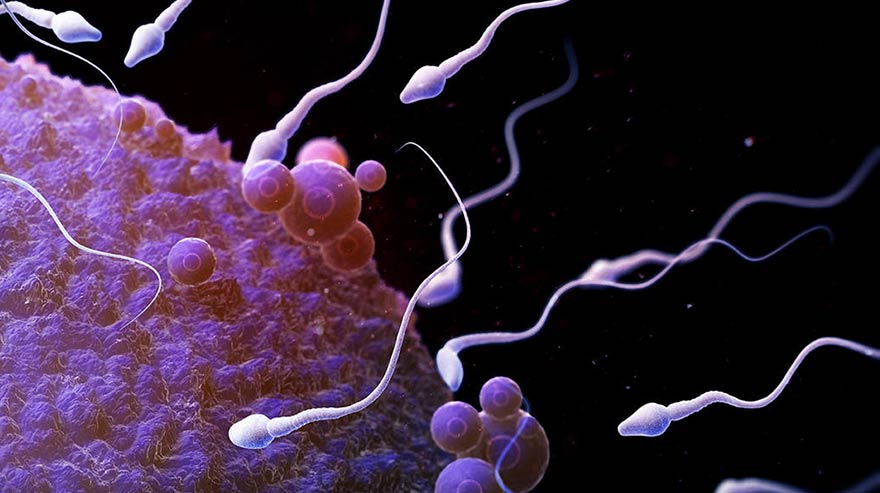Des chercheurs de la startup Kallistem ont annoncé la semaine dernière avoir réussi à obtenir des spermatozoïdes à partir de tissus prélevés sur le corps d’hommes infertiles souhaitant avoir un enfant biologique. Des spermatozoïdes fabriqués in vitro ? L’annonce a fait l’effet d’un grand bruit médiatique, suscitant immédiatement enthousiasme et controverse.
Cela fait une trentaine d’années que des équipes de chercheurs du monde entier travaillent sur ce sujet extraordinairement compliqué. En effet, le Journal du CNRS rappelle que la spermatogenèse humaine est un processus physiologique qui se réalise pendant une période de 72 à 74 jours et constitue l’un des processus physiologiques les plus complexes de la nature. Elle débute avec les cellules germinales immatures, les spermatogonies, nichées dans les tubes séminifères des testicules. Lors de trois grandes étapes successives (mitose, étape méiotique et spermiogenèse), ces cellules rondes riches de 46 chromosomes subissent une série de multiplications et de transformations pour aboutir aux spermatozoïdes, des cellules allongées à 23 chromosomes. Chez l’homme, le processus débute à la puberté et se poursuit pendant toute la vie adulte.
Le projet de reproduire la spermatogenèse in vitro remonte au début des années 1990. C’est à ce moment que des équipes de l’INSERM et de l’INRA dirigées par le biologiste Philippe Durand, l’actuel directeur scientifique de la société Kallistem à l’origine de l’annonce, se lancent dans l’aventure. Ils réussissent assez rapidement leur premier système de culture et réalisent en 2000 tout le processus méiotique de la spermatogenèse chez le rat. Leur système a été validé par une vingtaine de publications scientifiques. Le problème est que, dans ce processus, la spermatogenèse ne s’accomplit qu’à 80 % et se bloque dès le début de l’étape finale. La difficulté vient selon les chercheurs de la solution de confinement qui n’est pas suffisamment stable pour permettre au processus d’aller jusqu’au bout.
Un exploit biotechnologique ?
Pour résoudre ce problème, l’équipe de Philippe Durand se rapproche d’une autre équipe de l’université Claude Bernard de Lyon, qui a fait, sous la conduite de Laurent David, de belles avancées sur les hydrogels. Il s’agit de biomatériaux constitués essentiellement d’eau, parfaits pour la culture cellulaire. Et ces matériaux remplissent leur promesse. Ils permettent au dispositif de reproduire parfaitement le confinement des tissus dans les testicules. C’est ce dispositif qui a été présenté officiellement la semaine dernière par les chercheurs de Kallistem. Les chercheurs affirment que « Ce bioréacteur assure un confinement parfait des tubes séminifères, propice à une spermatogénèse intégrale. Sa paroi en hydrogel permet la diffusion des éléments nutritifs du milieu de culture vers l’intérieur des tubes séminifères et maintient une concentration suffisante en hormones à l’intérieur des tubes ».
A ce stade, on peut parler d’exploit biotechnologique. En effet, Marie-Hélène Perrard, la dirigeante de Kallistem s’enthousiasme sur les résultats des premiers tests effectués sur des tissus de rats et de singes : « Après ouverture du bioréacteur et fragmentation des tubes séminifères, on a observé au microscope des spermatozoïdes ». Cette réussite est présentée dans un article scientifique en cours de validation. C’est là que l’enthousiasme doit être tempéré pour éviter de susciter de faux espoirs auprès des patients souffrant de stérilité. En effet, la validation n’est pas encore acquise par l’ensemble de la communauté scientifique et l’on peut s’interroger sur la précipitation dont cette annonce a fait l’objet.
Effet d’annonce ou réalité scientifique ?
La startup Kallistem est issue de l’Institut de génomique fonctionnelle de Lyon ; elle possède une solide équipe de chercheurs du CNRS et de l’INRA. On peut donc assez légitimement leur faire crédit sur la qualité et le sérieux de leur travail. Ce qui pose question est la stratégie de communication choisie. En effet, la société a choisi de faire le buzz dans les médias, sans attendre l’agrément de la communauté scientifique. Dès le 5 mai, la société annonçait dans un communiqué de presse être parvenue à fabriquer des spermatozoïdes humains complets, in vitro. « Une première mondiale ! ». Toutefois aucune preuve scientifique n’accompagnait cette annonce. Et les chercheurs se gardaient de toute réponse aux sollicitations des médias forcément attirés par cette information. La raison donnée est compréhensible : les chercheurs ne pouvaient parler car leur demande de brevets déposée en 2013 était en cours. Soit. Ce brevet pour le procédé Artistem a été rendu public fin mai dernier, libérant la parole des chercheurs qui se sont empressés de communiquer. Pourquoi si vite ?
La société Kallistem est hébergée par l’Ecole normale supérieure de Lyon et n’en est pas encore à gagner de l’argent ; au contraire, elle est actuellement en pleine levée de fonds, à la recherche, selon Les Echos, de 2 millions d’Euros pour mener à bout ses travaux. Isabelle Cuoc, la CEO de Kallistem, n’hésite d’ailleurs pas à déclarer avec franchise : « Nous sommes une start-up et nous avons certes un agenda de recherche, mais aussi un agenda financier. Il nous faut concilier les deux, mais nous sommes actuellement en période de levée de fonds et nos investisseurs avaient besoin que nous communiquions sur notre projet. »
La société publie donc quelques précisions sur la technologie employée mais pas encore de résultats tangibles qui pourraient être soumis à la validation des scientifiques. Ces derniers sont donc, dans leur ensemble, relativement circonspects. Le Professeur Louis Bujan, spécialiste de la reproduction, interrogé par le Monde, déclare « Nous attendons avec impatience une publication scientifique validée par les pairs. Mais d’ici là, il est difficile de se prononcer ». Il en est de même de la professeure Isabelle Rives qui travaille depuis longtemps sur les mêmes thématiques et fait part de son embarras : « Ils ont fourni quelques explications sur la matrice utilisée, mais aucune statistique, aucun détail quant au nombre d’expériences réalisées… C’est ennuyeux sur le plan scientifique ».
Cette précipitation est un symptôme de la concurrence que se livrent les laboratoires mondiaux dans la course aux biotechnologies, avec un enjeu majeur : la recherche de financements. Les biotechnologies sont un domaine en plein bouillonnement qui fait l’objet de batailles économiques et financières considérables. Et le domaine de l’infertilité masculine est un marché important qui représente, selon les chiffres avancés par Les Echos, 2.3 milliards de dollars au niveau mondial. Les chercheurs sont pris en tenaille entre le rythme et les pratiques de la science d’une part et d’autre part, la nécessité d’aller vite pour se financer et conquérir des parts de marché.
La route est encore longue
Pourtant la route est encore longue de l’éprouvette à la réalité des patients. Le long périple des essais cliniques reste à faire ; il faut encore vérifier que les spermatozoïdes obtenus in vitro sont fonctionnels et de bonne qualité, qu’ils sont capables d’être fécondants et de donner naissance à des organismes viables et normaux. Ces étapes sont semées d’embûches scientifiques mais aussi règlementaires. On ne sait encore aujourd’hui comment se prononcera à cet égard l’Agence nationale de sécurité du médicament et des produits de santé ni les autorités chargées de veiller à la bioéthique de ce type de recherche.
S’abonner
Connexion
0 Commentaires
Inline Feedbacks
View all comments












